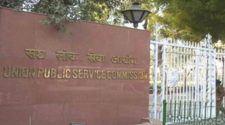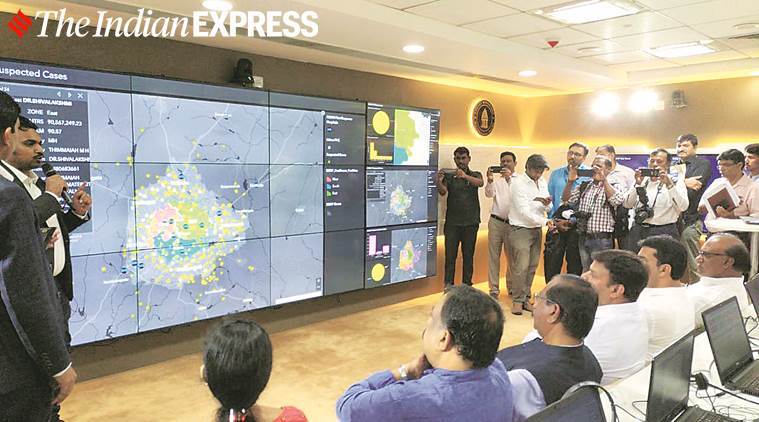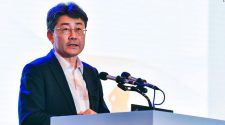| Bengaluru |
Published: March 30, 2020 12:16:32 am
View of Covid-19 war room at Bengaluru city council headquarters.
One of the crucial elements in successfully surmounting the challenge posed by the spread of Coronavirus in countries like South Korea, Singapore and even China was the use of data from technologies like the Global Positioning System (GPS), mobile phone apps etc. While health workers tended to patients, experts in the use of modern communication and surveillance technologies worked behind the scenes to deploy technology to prevent the fast spread of the disease.
Learning from countries like South Korea, the Karnataka government has now turned to its in-house experts on technology, and the IT resource base in Bengaluru.
One of the tasks assigned to a 10-member Covid-19 task force — comprising IAS officers with expertise in the fields of technology, medicine and healthcare — is to develop a system to track all persons who visited foreign countries during the period of the Covid-19 outbreak. The system, which should be ready in the next few days, would also track those who have tested positive and all their known and unknown contacts.
Significance of using technology
The best way to combat Coronavirus is to contain its spread. That’s where Karnataka government has learnt from the experience of South Korea, which leveraged surveillance technologies to effectively track those individuals who were infected and fast spreading the virus. The Corona Watch app is the first such effort.
Different “Applications (or Apps)” are already in the pipeline for informing people about the places where they may have come in contact with a Covid-19 positive person. There are apps for checking on persons in quarantine, and for geofencing places with a large number of infections.
One of the applications for mobile phones called “Corona Watch,” which gives details of places visited by Covid-19 positive persons in Karnataka in the 14-day incubation period of the virus, has already been released through the state government’s official portal.
The estimated number of travellers — the primary target of surveillance since the virus is known to have come from affected countries — who have returned since the outbreak is 40,000. A total of 21,509 persons from 28 districts of the state returned from foreign countries between March 10 — when data collection began — and March 23 — when international flights were halted in the state. As of March 26, there were a total of 56 Covid-19 positive cases detected in Karnataka with 55 of them involving persons who recently returned from foreign countries — including two elderly persons who have died within days of returning from pilgrimages to Saudi Arabia.
“What we are finding is that if we have 40 to 50 coronavirus patients the number of their contacts runs into 10 times the number of patients. Everybody in the family becomes a primary contact. By chance if one person happened to go to a concert — as it happened in one case — then certainly 300 people need to be isolated,” says IAS officer Munish Moudgil, Secretary (Administrative Reforms) and member of the state task force for containing Covid-19 with the specific responsibility for looking at the use of IT and related activities to contain the virus.
“The whole effort in India and Karnataka is to ensure that the number of patients who need intervention does not go beyond the capacity of the health system. It is not going to be easy. For that to happen at this juncture we are trying to prevent community spread and in this situation, technology can play an important role,” said Moudgil, an IIT Bombay graduate who has used technology for farm loan waivers and urban land record digitisation in Karnataka.
Since testing everyone for the coronavirus is impractical at this stage, the best-acknowledged means of curbing the spread of the virus is through social distancing or cutting off all social interaction for 14 days — which is the incubation period of the virus — in the understanding that this will stop its community spread.
“Bangalore has 25 lakh households or families and the total number of people who arrived from abroad since the whole Coronavirus issue started is 40,000. Theoretically, If we had successfully quarantined all 40,000 people after they returned, along with their families, there would probably have been no escalation beyond these 40,000 people,” Moudgil said.
“Keeping a watch on this 40,000 people is only possible through technology. It is just not possible to send the whole police force to sit outside the houses of people,” he said.
One of the first apps — on the lines of those deployed in South Korea to track the persons in self-quarantine — is almost ready and will require voluntary participation by the quarantined persons to declare their location every day during the 14-day-period, the official said.
“What we are doing right now is developing an app which will be out in a few days. We will give this app in the hands of the people and those who are self-quarantined will have to report on this app every half an hour or one hour, let us say. If a person does not report then we will send a follow up physical verification team of the police,” Moudgil said.
The home quarantine app will require people to click their photo and send it to health officials who will be able to use geotags of the photo to know where the picture is taken. With several home-quarantined persons found socialising and visiting theatres, malls, play areas, the app is expected to curb this during the mandatory period of social isolation.
“The other thing we are trying to do with technology is that we are using software and data from telecom service providers to get information on people who were in the vicinity of these people and we will notify them saying — ‘you were in the vicinity of Mr Y who is now a corona positive patient. Please report for a quarantine’,” the IAS officer said.
The task force is using tower location information from telecom providers and available apps to notify people about their possible interaction with Covid-19 positive persons.
Here’s a quick Coronavirus guide from Express Explained to keep you updated: Are smokers at high risk form coronavirus? | Can Vitamin-C prevent or cure coronavirus infection? | What exactly is community spread of coronavirus? | How long can the Covid-19 virus survive on a surface? | Amid the lockdown, what is allowed, what is prohibited?
📣 The Indian Express is now on Telegram. Click here to join our channel (@indianexpress) and stay updated with the latest headlines
For all the latest Governance News, download Indian Express App.
© IE Online Media Services Pvt Ltd

















